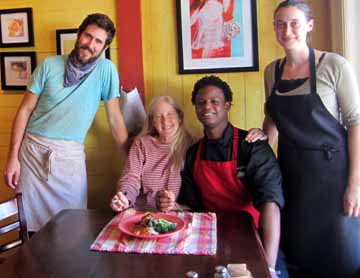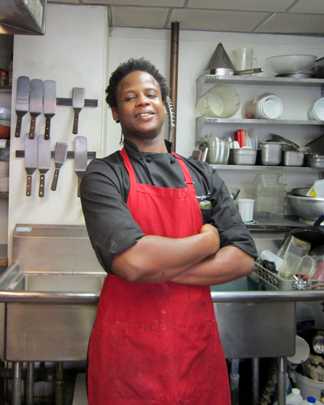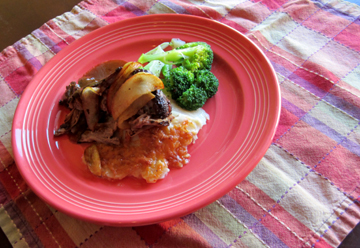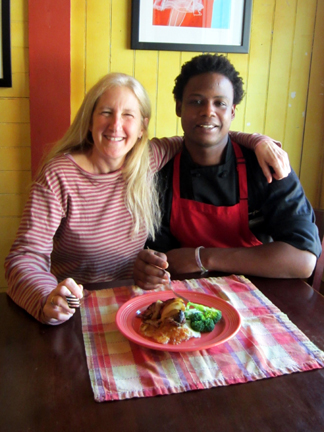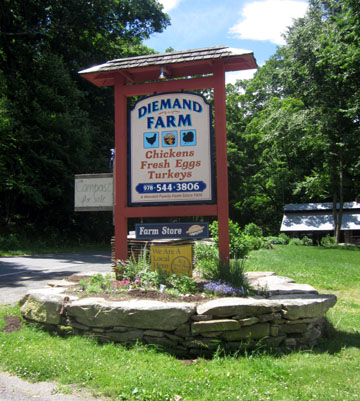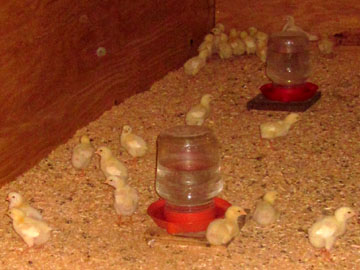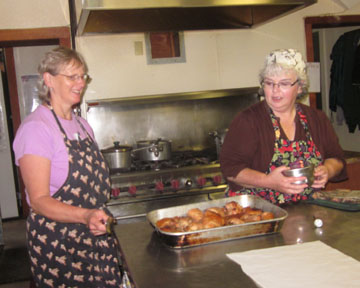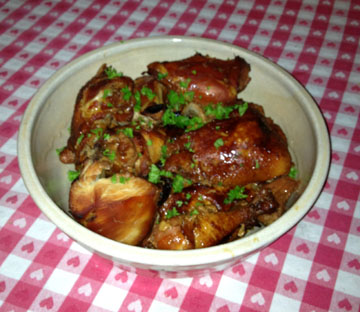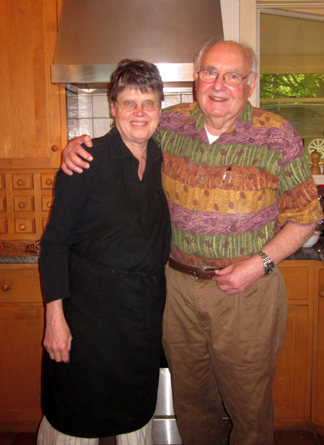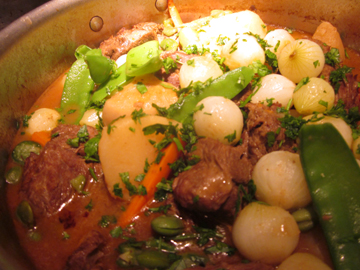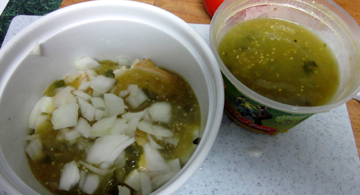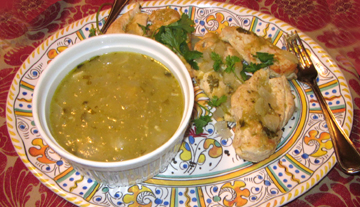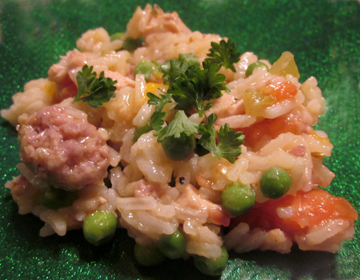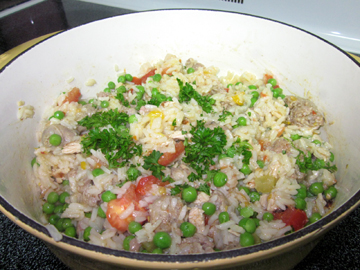Elmer’s Store on Main Street in Ashfield, Massachusetts, is a bright, friendly place. Owner Nan Parati and her staff smile as they sell food and gifts. The walls are painted vibrant colors mixed by Nan herself; she is an artist and set designer as well as a storekeeper. And on Friday afternoons and evenings irresistible smells emanate from the small, well lit kitchen.
On a recent Friday afternoon when I stopped in, kitchen manager Jane Goodale, assistant chef Michael Hulbert, and chef Son Tremé were chopping, washing, and peeling local vegetables and meat for Elmer’s weekly Friday dinner. They joked and chatted as they worked, clearly at ease in the kitchen and with each other.
Son Tremé is an assured 28 year old with a warm smile. Nan Parati told me that she has known him since he was six. “I met him when I lived in New Orleans, in the Tremé section of the city,” she explained. “He and his little brother came over and just kind of wouldn’t go away.”
I asked Nan about Son’s name. “’Son’ was his nickname growing up,” she informed me, “but he made it his legal name.” He apparently added “Tremé” to his legal name as well. Who am I to cavil at a name? I assure you that “Tinky” doesn’t appear on my birth certificate. Son’s name suits him.
Nan added that she became a godmother of sorts to Tremé, so much so that when her own mother died recently “the grandchildren decided that Son should represent them at the service.”
Son began working in the restaurant business in New Orleans, he said, although he didn’t plan at first to cook as a career. He enjoyed the rich food of his native city, but it wasn’t until he moved north and started cooking more healthily that he knew for sure he was going to be a chef.
He worked at a number of restaurants in Massachusetts, ending up as a breakfast chef at Elmer’s before taking time off to work on a culinary degree from Johnson & Wales University. He has finished his coursework and is scheduled to graduate in 2013. “As you can imagine, I am extremely proud of him!” beamed Nan Parati.
Son Tremé explained that he combines all of his food background in his work at Elmer’s. “My home training is all pot stuff. I do it the way I want to,” he said. He added that his schooling taught him to be more precise in his cooking. His practical experience has made him even more responsible.
“In school you have five people on one soup,” he said. “In the industry it’s YOUR soup. And it’s your butt if it’s good or bad.”
Son does his best to respond to the desires and needs of his patrons and to the agricultural abundance in our area. He sees the relationship among farmers, restaurateurs, diners, and home cooks as a “circle of support.”
His home circle is also important to him. He is planning to create special food soon for the little baby girl to whom his partner gave birth in early October. “She’s my inspiration these days,” he said of little Belle-Soleil Tremé.
Nan and Son hope to expand the culinary offerings at Elmer’s, which currently serves breakfast and lunch every day (with special brunches on the weekend) and dinner on Friday evenings only. Soon another Louisiana chef, Charles Neville, will cook on the first Saturday evening of each month.
Meanwhile, Son Tremé plans future menus and enjoys the spirit in the kitchen. “My style is basically international fusion, which is Creole, my native culture,” he said. “All those indigenous cultures merged together in New Orleans. It says a lot about me. We cook. We sit down and eat—and we talk.”
I’d cook, talk, and eat with Son any day of the week. (He is the only chef who has ever kissed my hand at the end of an interview.) I was particularly taken with the seasonal, slightly sweet pork dish he served that evening at Elmer’s.
Son Tremé’s Apple-Cider Braised Pork Roast
When I made this for my family, I cut the recipe for the marinade in half and used 2 pounds of pork tenderloin. We had enough for eight people. Obviously, Son is a generous chef! (I didn’t have to cook the smaller amount of meat quite so long.)
Ingredients:
1/2 pound shallots (about 3 to 4 shallots, plus a few more if you love shallots), peeled and chopped
1/2 cup minced garlic
1 cup balsamic vinegar
1 bunch fresh parsley
salt and pepper to taste
1 quart apple cider
5 pounds picnic pork shoulder
1/4 cup canola oil
Instructions:
Gather all your ingredients and equipment.
In a blender mix the shallots, garlic, vinegar, parsley, salt, and pepper. Add the cider to this combination. Place the pork in a pan, and marinate it in the liquids (refrigerated) for 24 hours.
The next day, preheat the oven to 300 degrees. Remove the pork from the marinade, saving the marinade.
Heat the oil in a Dutch oven, and sear the pork to brown it.
In a saucepan bring the marinade to a boil. Pour it over the pork, cover the Dutch oven, and place it in the oven. Bake the pork until it is fork tender, 2-1/2 to 3 hours.
Transfer the pork, moistened with a little of the liquid and tightly covered, to a cooler oven (250 degrees) or to the oven you have just been using turned off. Strain the cooking liquid. Discard the solids that come out in the straining (the garlic, etc.).
Skim the sauce, and bring it to a simmer. Let it simmer and reduce until it is slightly thickened and glossy. (Start checking for this after about 15 minutes.)
Slice the pork, and serve it with some of the sauce and thinly sliced, sautéed apples.
Serves 10.

